Conceptual Model for Integrated Meso-Scale Fire Risk Assessment in the Coastal Catchments in Croatia
Abstract
:1. Introduction
2. Materials and Methods
2.1. Study Areas
2.2. Land Use/Land Cover (LULC) Data
2.3. Terrain Characteristics
2.4. Population Density Data
2.5. Natura 2000
2.6. Burned Areas and Burn Severity
2.7. Framework for Fire Hazard and Risk Assessment
- Generation of input variables for risk components;
- Assessment of risk components (hazard, exposure, and vulnerability);
- Fire risk assessment;
- Validation.
2.7.1. Fire Hazard
- Any woody vegetation is prone to fire ignition and can support fire spread under sufficiently dry conditions [71].
- A home ignition zone is located within a 100 m buffer from built-up areas. All surfaces inside the buffer are assumed to be potentially at risk (potential WUI areas).
- Fire behavior is influenced by the proportion of woody vegetation neighboring potential WUI areas. If more than 50% of land cover surrounding buildings within a 500 m radius from them is woody vegetation, buildings are directly exposed to fire and areas are identified as intermix WUI.
- Continuous woody vegetation cover close to buildings increases the risk from wildfire; therefore, patches of woody vegetation larger than 5 km2 [67] are delineated. Buildings within a 600 m radius from those large patches are identified as interface WUI.
2.7.2. Fire Exposure and Vulnerability
2.7.3. Validation of the Results
3. Results
P’(i) = [P(i) − α]/[1 − α∙PCR] for critical alternative
4. Discussion
5. Conclusions
Author Contributions
Funding
Data Availability Statement
Conflicts of Interest
Appendix A
| Relative Importance Intensity | Definition | Description |
|---|---|---|
| 1 | Equal importance | Two activities contribute equally to the objective |
| 3 | Weak importance of one over another | Experience and judgement slightly favor one activity over another |
| 5 | Strong importance of one over another | Experience and judgement strongly favor one activity over another |
| 7 | Very strong importance of one over another | An activity is strongly favored and its dominance demonstrated |
| 9 | Absolute importance | The evidence favoring one activity over another is of the highest possible order or affirmation |
| 2, 4, 6, 8 | Intermediate values | When compromise is needed between two levels of importance |
| n | 1 | 2 | 3 | 4 | 5 | 6 | 7 | 8 | 9 | 10 |
|---|---|---|---|---|---|---|---|---|---|---|
| RI | 0 | 0 | 0.52 | 0.89 | 1.11 | 1.25 | 1.35 | 1.4 | 1.45 | 1.49 |
| Urban | Cropland | Grassland | Woodland and Forest | Wetland | Heathland | Sparsely Vegetated Areas | Rivers and Lakes | Marine Inlets and Transitional Waters | |
|---|---|---|---|---|---|---|---|---|---|
| Crop provision | 0 | 100% | 0 | 0 | 0 | 0 | 0 | 0 | 0 |
| Timber provision | 0 | 0 | 0 | 100 | 0 | 0 | 0 | 0 | 0 |
| Crop pollination | N/A * | 100% | N/A * | N/A * | 0 | N/A * | 0 | 0 | 0 |
| Carbon sequestration | 0 | 0 | 0 | 100 | 0 | 0 | 0 | N/A * | N/A * |
| Flood control | 0.6% | 6.2% | 19.2% | 69.8% | 2% | 2.2% | 0.01% | N/A * | N/A * |
| Water purification | 2% | 55.9% | 7.4% | 27.7% | 0.6% | 0.6% | 0.3% | 5.6% | N/A * |
| Nature-based recreation | 0.2% | 8.1% | 14.9% | 61% | 4.6% | 6.2% | 2.7% | 2% | 0.6% |
| Relative supply per ecosystem type | 0.7% | 35.8 % | 8.6% | 47.5% | 2.2% | 0.9% | 1.7% | 2.4% | 0.2% |
| Alternatives vs. Attributes | |||||||
|---|---|---|---|---|---|---|---|
| Fuel Type | FMC | Slope | Aspect | Concavity | Priority | CR | |
| Fuel type | 1 | 0.33 | – | – | – | 0.25 | 0.7% |
| FMC | 3 | 1 | – | – | – | 0.75 | |
| Slope | – | – | 1 | 3 | 5 | 0.648 | 0.4% |
| Aspect | – | – | 0.33 | 1 | 2 | 0.23 | |
| Concavity | – | – | 0.2 | 0.5 | 1 | 0.122 | |
| FWI | |||||||
| Attributes vs. Objectives | |||||||
| Settlements | Roads | Fuels | Terrain | Weather | Priority | CR | |
| Settlements | 1 | 0.14 | – | – | – | 0.125 | 0.7% |
| Roads | 7 | 1 | – | – | – | 0.875 | |
| Fuels | – | – | 1 | 4 | 2 | 0.558 | 1.9% |
| Terrain | – | – | 0.25 | 1 | 0.33 | 0.122 | |
| Weather | – | – | 0.5 | 3 | 1 | 0.32 | |
| Alternatives vs. Attributes | ||||||
|---|---|---|---|---|---|---|
| Ecosystem Services | Ecological Value | Population | Assets | Priority | CR | |
| Ecosystem services | 1 | 0.5 | 0.11 | 0.5 | 0.061 | 1.7% |
| Ecological value | 2 | 1 | 0.11 | 1 | 0.102 | |
| Population | 9 | 9 | 1 | 7 | 0.729 | |
| Assets | 2 | 1 | 0.14 | 1 | 0.108 | |
References
- Wasserman, T.N.; Mueller, S.E. Climate Influences on Future Fire Severity: A Synthesis of Climate-Fire Interactions and Impacts on Fire Regimes, High-Severity Fire, and Forests in the Western United States. Fire Ecol. 2023, 19, 43. [Google Scholar] [CrossRef]
- OECD. Taming Wildfires in the Context of Climate Change; OECD: Paris, France, 2023; ISBN 9789264609211. [Google Scholar]
- UNEP. Spreading Like Wildfire—The Rising Threat of Extraordinary Landscape Fires; UNEP: Nairobi, Kenya, 2022. [Google Scholar]
- Soulis, K.X.; Generali, K.A.; Papadaki, C.; Theodoropoulos, C.; Psomiadis, E. Hydrological Response of Natural Mediterranean Watersheds to Forest Fires. Hydrology 2021, 8, 15. [Google Scholar] [CrossRef]
- Stoof, C.R.; Vervoort, R.W.; Iwema, J.; van den Elsen, E.; Ferreira, A.J.D.; Ritsema, C.J. Hydrological Response of a Small Catchment Burned by Experimental Fire. Hydrol. Earth Syst. Sci. 2012, 16, 267–285. [Google Scholar] [CrossRef]
- Versini, P.-A.; Velasco, M.; Cabello, A.; Sempere-Torres, D. Hydrological Impact of Forest Fires and Climate Change in a Mediterranean Basin. Nat. Hazards 2013, 66, 609–628. [Google Scholar] [CrossRef]
- Leopardi, M.; Scorzini, A. Effects of Wildfires on Peak Discharges in Watersheds. IForest 2015, 8, 302–307. [Google Scholar] [CrossRef]
- Hrelja, I.; Šestak, I.; Bogunović, I. Wildfire Impacts on Soil Physical and Chemical Properties—A Short Review of Recent Studies. Agric. Conspec. Sci. 2020, 85, 293–301. [Google Scholar]
- Wang, J.; Song, W.; Zheng, H.; Telesca, L. Temporal Scaling Behavior of Human-Caused Fires and Their Connection to Relative Humidity of the Atmosphere. Ecol. Model. 2010, 221, 85–89. [Google Scholar] [CrossRef]
- Tedim, F.; Xanthopoulos, G.; Leone, V. Forest Fires in Europe. In Wildfire Hazards, Risks and Disasters; Elsevier: Amsterdam, The Netherlands, 2015; pp. 77–99. [Google Scholar]
- van Oldenborgh, G.J.; Krikken, F.; Lewis, S.; Leach, N.J.; Lehner, F.; Saunders, K.R.; van Weele, M.; Haustein, K.; Li, S.; Wallom, D.; et al. Attribution of the Australian Bushfire Risk to Anthropogenic Climate Change. Nat. Hazards Earth Syst. Sci. 2021, 21, 941–960. [Google Scholar] [CrossRef]
- Calvin, K.; Dasgupta, D.; Krinner, G.; Mukherji, A.; Thorne, P.W.; Trisos, C.; Romero, J.; Aldunce, P.; Barrett, K.; Blanco, G.; et al. IPCC, 2023: Climate Change 2023: Synthesis Report. Contribution of Working Groups I, II and III to the Sixth Assessment Report of the Intergovernmental Panel on Climate Change; Core Writing Team, Lee, H., Romero, J., Eds.; IPCC: Geneva, Switzerland, 2023. [Google Scholar]
- Sungmin, O.; Hou, X.; Orth, R. Observational Evidence of Wildfire-Promoting Soil Moisture Anomalies. Sci. Rep. 2020, 10, 11008. [Google Scholar] [CrossRef] [PubMed]
- Krueger, E.S.; Levi, M.R.; Achieng, K.O.; Bolten, J.D.; Carlson, J.D.; Coops, N.C.; Holden, Z.A.; Magi, B.I.; Rigden, A.J.; Ochsner, T.E. Using Soil Moisture Information to Better Understand and Predict Wildfire Danger: A Review of Recent Developments and Outstanding Questions. Int. J. Wildland Fire 2022, 32, 111–132. [Google Scholar] [CrossRef]
- Veraverbeke, S.; Rogers, B.M.; Goulden, M.L.; Jandt, R.R.; Miller, C.E.; Wiggins, E.B.; Randerson, J.T. Lightning as a Major Driver of Recent Large Fire Years in North American Boreal Forests. Nat. Clim. Chang. 2017, 7, 529–534. [Google Scholar] [CrossRef]
- Boyer, E.W.; Wagenbrenner, J.W.; Zhang, L. Wildfire and Hydrological Processes. Hydrol. Process 2022, 36, e14640. [Google Scholar] [CrossRef]
- Singh, S. Forest Fire Emissions: A Contribution to Global Climate Change. Front. For. Glob. Change 2022, 5, 925480. [Google Scholar] [CrossRef]
- Szpakowski, D.; Jensen, J. A Review of the Applications of Remote Sensing in Fire Ecology. Remote Sens. 2019, 11, 2638. [Google Scholar] [CrossRef]
- San-Miguel-Ayanz, J.; Durrant, T.; Boca, R.; Libertà, G.; Branco, A.; de Rigo, D.; Ferrari, D.; Maianti, P.; Vivancos, T.A.; Costa, H.; et al. Forest Fires in Europe, Middle East and North Africa 2017; European Commission, Joint Research Centre, Publication Office: Luxemburg, 2017. [Google Scholar]
- San-Miguel-Ayanz, J.; Durrant, T.; Boca, R.; Maianti, P.; Libertá, G.; Oom, D.; Branco, A.; de Rigo, D.; Suarez-Moreno, M.; Ferrari, D.; et al. Forest Fires in Europe, Middle East and North Africa 2022; European Commission, Joint Research Centre, Publication Office: Luxembourg, 2023. [Google Scholar]
- Hrenović, J.; Kisić, I.; Delač, D.; Durn, G.; Bogunović, I.; Mikulec, M.; Pereira, P. Short-Term Effects of Experimental Fire on Physicochemical and Microbial Properties of a Mediterranean Cambisol. Fire 2023, 6, 155. [Google Scholar] [CrossRef]
- Oom, D.; de Rigo, D.; Pfeiffer, H.; Branco, A.; Ferrari, D.; Grecchi, R.; Artés-Vivancos, T.; Houston Durrant, T.; Boca, R.; Maianti, P.; et al. Pan-European Wildfire Risk Assessment; EUR 31160 EN; Publication Office of the European Union: Luxembourg, 2022. [Google Scholar]
- European Union, 1995–2024 European Forest Fire Information System (EFFIS). Available online: https://effis.jrc.ec.europa.eu/apps/effis.statistics/estimates (accessed on 10 January 2024).
- Chuvieco, E.; Yebra, M.; Martino, S.; Thonicke, K.; Gómez-Giménez, M.; San-Miguel, J.; Oom, D.; Velea, R.; Mouillot, F.; Molina, J.R.; et al. Towards an Integrated Approach to Wildfire Risk Assessment: When, Where, What and How May the Landscapes Burn. Fire 2023, 6, 215. [Google Scholar] [CrossRef]
- Tagarev, T.; Papadopoulos, G.A.; Hagenlocher, M.; Sliuzas, R.; Ishiwatari, M.; Gallego, E. Integrating the Risk Management Cycle. In Science for Disaster Risk Management 2020: Acting Today, Protecting Tomorrow; Casajus Valles, A., Marin Ferrer, M., Poljanšek, K., Clark, I., Eds.; Publications Office of the European Union: Luxembourg, 2020. [Google Scholar]
- Trucchia, A.; Meschi, G.; Fiorucci, P.; Provenzale, A.; Tonini, M.; Pernice, U. Wildfire Hazard Mapping in the Eastern Mediterranean Landscape. Int. J. Wildland Fire 2023, 32, 417–434. [Google Scholar] [CrossRef]
- Meng, Y.; Deng, Y.; Shi, P. Mapping Forest Wildfire Risk of the World. In World Atlas Natural Disaster Risk; Shi, P., Kasperson, R., Eds.; Springer: Berling/Heidelberg, Germany, 2015; pp. 261–275. [Google Scholar] [CrossRef]
- IPCC. Managing the Risks of Extreme Events and Disasters to Advance Climate Change Adaptation. A Special Report of Working Groups I and II of the Intergovernmental Panel on Climate Change; Field, C.B., Barros, V., Stocker, T.F., Qin, D., Dokken, D.J., Ebi, K.L., Mastrandrea, M.D., Mach, K.J., Plattner, G.-K., Allen, S.K., et al., Eds.; Cambridge University Press: Cambridge, UK; New York, NY, USA, 2012. [Google Scholar]
- Marquez Torres, A.; Signorello, G.; Kumar, S.; Adamo, G.; Villa, F.; Balbi, S. Fire Risk Modeling: An Integrated and Data-Driven Approach Applied to Sicily. Nat. Hazards Earth Syst. Sci. 2023, 23, 2937–2959. [Google Scholar] [CrossRef]
- Maniatis, Y.; Doganis, A.; Chatzigeorgiadis, M. Fire Risk Probability Mapping Using Machine Learning Tools and Multi-Criteria Decision Analysis in the GIS Environment: A Case Study in the National Park Forest Dadia-Lefkimi-Soufli, Greece. Appl. Sci. 2022, 12, 2938. [Google Scholar] [CrossRef]
- Keane, R.E.; Drury, S.A.; Karau, E.C.; Hessburg, P.F.; Reynolds, K.M. A Method for Mapping Fire Hazard and Risk across Multiple Scales and Its Application in Fire Management. Ecol. Model. 2010, 221, 2–18. [Google Scholar] [CrossRef]
- Salis, M.; Ager, A.A.; Arca, B.; Finney, M.A.; Bacciu, V.; Duce, P.; Spano, D. Assessing Exposure of Human and Ecological Values to Wildfire in Sardinia, Italy. Int. J. Wildland Fire 2013, 22, 549. [Google Scholar] [CrossRef]
- Müller, M.M.; Vilà-Vilardell, L.; Vacik, H. Towards an Integrated Forest Fire Danger Assessment System for the European Alps. Ecol. Inf. 2020, 60, 101151. [Google Scholar] [CrossRef]
- Hessburg, P.F.; Reynolds, K.M.; Keane, R.E.; James, K.M.; Salter, R.B. Evaluating Wildland Fire Danger and Prioritizing Vegetation and Fuels Treatments. Ecol. Manag. 2007, 247, 1–17. [Google Scholar] [CrossRef]
- Gigović, L.; Jakovljević, G.; Sekulović, D.; Regodić, M. GIS Multi-Criteria Analysis for Identifying and Mapping Forest Fire Hazard: Nevesinje, Bosnia and Herzegovina. Teh. Vjesn.-Tech. Gaz. 2018, 25, 891–897. [Google Scholar] [CrossRef]
- Chuvieco, E.; Aguado, I.; Jurdao, S.; Pettinari, M.L.; Yebra, M.; Salas, J.; Hantson, S.; de la Riva, J.; Ibarra, P.; Rodrigues, M.; et al. Integrating Geospatial Information into Fire Risk Assessment. Int. J. Wildland Fire 2014, 23, 606. [Google Scholar] [CrossRef]
- Noori, S.; Mohammadi, A.; Miguel Ferreira, T.; Ghaffari Gilandeh, A.; Mirahmadzadeh Ardabili, S.J. Modelling and Mapping Urban Vulnerability Index against Potential Structural Fire-Related Risks: An Integrated GIS-MCDM Approach. Fire 2023, 6, 107. [Google Scholar] [CrossRef]
- Thompson, M.P.; Scott, J.; Helmbrecht, D.; Calkin, D.E. Integrated Wildfire Risk Assessment: Framework Development and Application on the Lewis and Clark National Forest in Montana, USA. Integr. Environ. Assess. Manag. 2013, 9, 329–342. [Google Scholar] [CrossRef]
- Ju, W.; Xing, Z.; Wu, J.; Kang, Q. Evaluation of Forest Fire Risk Based on Multicriteria Decision Analysis Techniques for Changzhou, China. Int. J. Disaster Risk Reduct. 2023, 98, 104082. [Google Scholar] [CrossRef]
- Dunn, C.J.; O’Connor, C.D.; Abrams, J.; Thompson, M.P.; Calkin, D.E.; Johnston, J.D.; Stratton, R.; Gilbertson-Day, J. Wildfire Risk Science Facilitates Adaptation of Fire-Prone Social-Ecological Systems to the New Fire Reality. Environ. Res. Lett. 2020, 15, 025001. [Google Scholar] [CrossRef]
- Jain, P.; Coogan, S.C.P.; Subramanian, S.G.; Crowley, M.; Taylor, S.; Flannigan, M.D. A Review of Machine Learning Applications in Wildfire Science and Management. Environ. Rev. 2020, 28, 478–505. [Google Scholar] [CrossRef]
- Chuvieco, E.; Pettinari, M.L.; Koutsias, N.; Forkel, M.; Hantson, S.; Turco, M. Human and Climate Drivers of Global Biomass Burning Variability. Sci. Total Environ. 2021, 779, 146361. [Google Scholar] [CrossRef] [PubMed]
- Hong, H.; Tsangaratos, P.; Ilia, I.; Liu, J.; Zhu, A.-X.; Xu, C. Applying Genetic Algorithms to Set the Optimal Combination of Forest Fire Related Variables and Model Forest Fire Susceptibility Based on Data Mining Models. The Case of Dayu County, China. Sci. Total Environ. 2018, 630, 1044–1056. [Google Scholar] [CrossRef] [PubMed]
- Singh, K.R.; Neethu, K.P.; Madhurekaa, K.; Harita, A.; Mohan, P. Parallel SVM Model for Forest Fire Prediction. Soft Comput. Lett. 2021, 3, 100014. [Google Scholar] [CrossRef]
- Li, Y.; Feng, Z.; Chen, S.; Zhao, Z.; Wang, F. Application of the Artificial Neural Network and Support Vector Machines in Forest Fire Prediction in the Guangxi Autonomous Region, China. Discret. Dyn. Nat. Soc. 2020, 2020, 5612650. [Google Scholar] [CrossRef]
- Tan, C.; Feng, Z. Mapping Forest Fire Risk Zones Using Machine Learning Algorithms in Hunan Province, China. Sustainability 2023, 15, 6292. [Google Scholar] [CrossRef]
- Kondylatos, S.; Prapas, I.; Ronco, M.; Papoutsis, I.; Camps-Valls, G.; Piles, M.; Fernández-Torres, M.; Carvalhais, N. Wildfire Danger Prediction and Understanding with Deep Learning. Geophys. Res. Lett. 2022, 49, e2022GL099368. [Google Scholar] [CrossRef]
- Hai, T.; Theruvil Sayed, B.; Majdi, A.; Zhou, J.; Sagban, R.; Band, S.S.; Mosavi, A. An Integrated GIS-Based Multivariate Adaptive Regression Splines-Cat Swarm Optimization for Improving the Accuracy of Wildfire Susceptibility Mapping. Geocarto Int. 2023, 38, 2167005. [Google Scholar] [CrossRef]
- Umunnakwe, A.; Parvania, M.; Nguyen, H.; Horel, J.D.; Davis, K.R. Data-Driven Spatio-Temporal Analysis of Wildfire Risk to Power Systems Operation. IET Gener. Transm. Distrib. 2022, 16, 2531–2546. [Google Scholar] [CrossRef]
- Khalid, R.; Khan, U.T. A Comparison of Multi-Criteria and Machine Learning Weighting for Flood Risk Assessment in the Southern Ontario, Canada. In Proceedings of the EGU General Assembly 2022, Vienna, Austria, 23–27 May 2022. [Google Scholar]
- Vojtek, M.; Vojteková, J.; Costache, R.; Pham, Q.B.; Lee, S.; Arshad, A.; Sahoo, S.; Linh, N.T.T.; Anh, D.T. Comparison of Multi-Criteria-Analytical Hierarchy Process and Machine Learning-Boosted Tree Models for Regional Flood Susceptibility Mapping: A Case Study from Slovakia. Geomat. Nat. Hazards Risk 2021, 12, 1153–1180. [Google Scholar] [CrossRef]
- Khuc, T.D.; Truong, X.Q.; Tran, V.A.; Bui, D.Q.; Bui, D.P.; Ha, H.; Tran, T.H.M.; Pham, T.T.T.; Yordanov, V. Comparison of Multi-Criteria Decision Making, Statistics, and Machine Learning Models for Landslide Susceptibility Mapping in Van Yen District, Yen Bai Province, Vietnam. Int. J. Geoinform. 2023, 19, 33–45. [Google Scholar] [CrossRef]
- Kumar, R.; Dwivedi, S.B.; Gaur, S. A Comparative Study of Machine Learning and Fuzzy-AHP Technique to Groundwater Potential Mapping in the Data-Scarce Region. Comput. Geosci. 2021, 155, 104855. [Google Scholar] [CrossRef]
- Krušić, J.; Marjanović, M.; Samardžić-Petrović, M.; Abolmasov, B.; Andrejev, K.; Miladinović, A. Comparison of Expert, Deterministic and Machine Learning Approach for Landslide Susceptibility Assessment in Ljubovija Municipality, Serbia. Geofizika 2017, 34, 251–273. [Google Scholar] [CrossRef]
- Bera, S.; Das, A.; Mazumder, T. Evaluation of Machine Learning, Information Theory and Multi-Criteria Decision Analysis Methods for Flood Susceptibility Mapping under Varying Spatial Scale of Analyses. Remote Sens. Appl. 2022, 25, 100686. [Google Scholar] [CrossRef]
- Gajić-Čapka, M.; Patarčić, M.; Perčec Tadić, M.; Srnec, L.; Zaninović, K. Spatial Distribution of Average Annual Air Temperature and Rainfall in Croatia (Prostorna Raspodjela Srednje Godišnje Temperature Zraka i Količine Oborina u Hrvatskoj). In Proceedings of the 3rd Croatian Water Conference: Croatia in 21st Century, Osijek, Croatia, 28–31 May 2003; Gereš, D., Ed.; Hrvatske Vode: Osijek, Croatia, 2003; pp. 75–81. [Google Scholar]
- Gajić-Čapka, M.; Perčic Tadić, M.; Patarčić, M. Digital Annual Precipitation Map of Croatia (Digitalna Oborinska Karta Hrvatske). Croat. Meteorol. J. 2003, 38, 21–33. [Google Scholar]
- EEA. CORINE Land Cover: Product User Manual (Version 1.0); European Union, Copernicus Land Monitoring Service, European Environmental Agency (EEA): Copenhagen, Denmark, 2021. [Google Scholar]
- GeoVille. Lot1: Imperviousness 2018, Imperviousness Change 2015–2018 and Built-Up 2018, User Manual. 2018. Available online: https://land.copernicus.eu/en/products/high-resolution-layer-imperviousness/imperviousness-change-2015-2018 (accessed on 6 June 2024).
- DZS. Census of Population, Households and Dwellings 2021. First Results by Settlements. Statistical Report; Croatian Bureau of Statistics: Zagreb, Croatia, 2022. [Google Scholar]
- Horvat, B.; Krvavica, N. Disaggregation of the Copernicus Land Use/Land Cover (LULC) and Population Density Data to Fit Mesoscale Flood Risk Assessment Requirements in Partially Urbanized Catchments in Croatia. Land 2023, 12, 2014. [Google Scholar] [CrossRef]
- Keeley, J.E. Fire Intensity, Fire Severity and Burn Severity: A Brief Review and Suggested Usage. Int. J. Wildland Fire 2009, 18, 116. [Google Scholar] [CrossRef]
- Miller, J.D.; Thode, A.E. Quantifying Burn Severity in a Heterogeneous Landscape with a Relative Version of the Delta Normalized Burn Ratio (DNBR). Remote Sens. Environ. 2007, 109, 66–80. [Google Scholar] [CrossRef]
- Key, C.H.; Benson, N.C. Landscape Assessment (LA): Sampling and Analysis Methods. 2006. Available online: http://gsp.humboldt.edu/OLM/Courses/GSP_216/labs/rmrs_gtr164_13_land_assess.pdf (accessed on 6 June 2024).
- FirEUrisk Project FirEUrisk. Available online: https://fireurisk.eu/ (accessed on 7 January 2024).
- Davis, J.B. The Wildland-Urban Interface: Paradise or Battleground? J. For. 1990, 88, 26–31. [Google Scholar] [CrossRef]
- Radeloff, V.C.; Hammer, R.B.; Stewart, S.I.; Fried, J.S.; Holcomb, S.S.; McKeefry, J.F. The Wildland-Urban Interface in the United States. Ecol. Appl. 2005, 15, 799–805. [Google Scholar] [CrossRef]
- Kumar, M.; Li, S.; Nguyen, P.; Banerjee, T. Examining the Existing Definitions of Wildland-urban Interface for California. Ecosphere 2022, 13, e4306. [Google Scholar] [CrossRef]
- USDI; USDA. Federal Wildland Fire Management: Policy and Program Review, Final Report; United Stated Department of Interior, United States Department of Agriculture: Washington, DC, USA, 1995. [Google Scholar]
- Del Giudice, L.; Arca, B.; Scarpa, C.; Pellizzaro, G.; Duce, P.; Salis, M. The Wildland-Anthropic Interface Raster Data of the Italy–France Maritime Cooperation Area (Sardinia, Corsica, Tuscany, Liguria, and Provence-Alpes-Côte d’Azur). Data Brief 2021, 38, 107355. [Google Scholar] [CrossRef] [PubMed]
- Bar-Massada, A.; Alcasena, F.; Schug, F.; Radeloff, V.C. The Wildland—Urban Interface in Europe: Spatial Patterns and Associations with Socioeconomic and Demographic Variables. Landsc. Urban. Plan. 2023, 235, 104759. [Google Scholar] [CrossRef]
- Mitsopoulos, I.; Mallinis, G.; Dimitrakopoulos, A.; Xanthopoulos, G.; Eftychidis, G.; Goldammer, J.G. Vulnerability of Peri-urban and Residential Areas to Landscape Fires in Greece: Evidence by Wildland-Urban Interface Data. Data Brief 2020, 31, 106025. [Google Scholar] [CrossRef] [PubMed]
- Modugno, S.; Balzter, H.; Cole, B.; Borrelli, P. Mapping Regional Patterns of Large Forest Fires in Wildland–Urban Interface Areas in Europe. J. Environ. Manag. 2016, 172, 112–126. [Google Scholar] [CrossRef]
- Radeloff, V.C.; Helmers, D.P.; Kramer, H.A.; Mockrin, M.H.; Alexandre, P.M.; Bar-Massada, A.; Butsic, V.; Hawbaker, T.J.; Martinuzzi, S.; Syphard, A.D.; et al. Rapid Growth of the US Wildland-Urban Interface Raises Wildfire Risk. Proc. Natl. Acad. Sci. USA 2018, 115, 3314–3319. [Google Scholar] [CrossRef] [PubMed]
- Carlson, A.R.; Helmers, D.P.; Hawbaker, T.J.; Mockrin, M.H.; Radeloff, V.C. The Wildland–Urban Interface in the United States Based on 125 Million Building Locations. Ecol. Appl. 2022, 32, e2597. [Google Scholar] [CrossRef] [PubMed]
- Cohen, J.D. Preventing Disaster: Home Ignitability in the Wildland-Urban Interface. J. For. 2000, 98, 15–21. [Google Scholar] [CrossRef]
- Tikotzki, I.; Bar-Massada, A.; Levin, N. A Geographically Flexible Approach for Mapping the Wildland-Urban Interface Integrating Fire Activity Data. Front. Environ. Sci. 2023, 11, 1231490. [Google Scholar] [CrossRef]
- Ye, J.; Wu, M.; Deng, Z.; Xu, S.; Zhou, R.; Clarke, K.C. Modeling the Spatial Patterns of Human Wildfire Ignition in Yunnan Province, China. Appl. Geogr. 2017, 89, 150–162. [Google Scholar] [CrossRef]
- Ricotta, C.; Bajocco, S.; Guglietta, D.; Conedera, M. Assessing the Influence of Roads on Fire Ignition: Does Land Cover Matter? Fire 2018, 1, 24. [Google Scholar] [CrossRef]
- Romero-Calcerrada, R.; Novillo, C.J.; Millington, J.D.A.; Gomez-Jimenez, I. GIS Analysis of Spatial Patterns of Human-Caused Wildfire Ignition Risk in the SW of Madrid (Central Spain). Landsc. Ecol. 2008, 23, 341–354. [Google Scholar] [CrossRef]
- EFFIS. European Fuel Map, 2017, Based on JRC Contract Number 384347 on the “Development of a European Fuel Map”. European Union, Copernicus Land Monitoring Service. 2017. Available online: https://forest-fire.emergency.copernicus.eu/applications/data-and-services (accessed on 15 January 2024).
- Albini, F.A. Estimating Wildfire Behavior and Effects; Gen. Tech. Rep. INT-GTR-30; Department of Agriculture, Forest Service, Intermountain Forest and Range Experiment Station: Ogden, UT, USA, 1976. [Google Scholar]
- Anderson, H.E. Aids to Determining Fuel Models for Estimating Fire Behavior; Gen. Tech. Rep. INT-GTR-122; US Department of Agriculture, Forest Service, Intermountain Forest and Range Experiment Station: Ogden, UT, USA, 1982. [Google Scholar]
- Qi, Y.; Dennison, P.E.; Spencer, J.; Riaño, D. Monitoring Live Fuel Moisture Using Soil Moisture and Remote Sensing Proxies. Fire Ecol. 2012, 8, 71–87. [Google Scholar] [CrossRef]
- Bakšić, N.; Bakšić, D.; Jazbec, A. Hourly Fine Fuel Moisture Model for Pinus Halepensis (Mill.) Litter. Agric. Meteorol. 2017, 243, 93–99. [Google Scholar] [CrossRef]
- Bakšić, N.; Bakšić, D. Predicting the Fine Fuel Moisture Content in Dalmatian Black Pine Needle Litter. Int. J. Wildland Fire 2022, 31, 708–719. [Google Scholar] [CrossRef]
- Aguado, I.; Chuvieco, E.; Borén, R.; Nieto, H. Estimation of Dead Fuel Moisture Content from Meteorological Data in Mediterranean Areas. Applications in Fire Danger Assessment. Int. J. Wildland Fire 2007, 16, 390. [Google Scholar] [CrossRef]
- Quan, X.; Yebra, M.; Riaño, D.; He, B.; Lai, G.; Liu, X. Global Fuel Moisture Content Mapping from MODIS. Int. J. Appl. Earth Obs. Geoinf. 2021, 101, 102354. [Google Scholar] [CrossRef]
- Dragozi, E.; Giannaros, T.M.; Kotroni, V.; Lagouvardos, K.; Koletsis, I. Dead Fuel Moisture Content (DFMC) Estimation Using MODIS and Meteorological Data: The Case of Greece. Remote Sens. 2021, 13, 4224. [Google Scholar] [CrossRef]
- Marino, E.; Yebra, M.; Guillén-Climent, M.; Algeet, N.; Tomé, J.L.; Madrigal, J.; Guijarro, M.; Hernando, C. Investigating Live Fuel Moisture Content Estimation in Fire-Prone Shrubland from Remote Sensing Using Empirical Modelling and RTM Simulations. Remote Sens. 2020, 12, 2251. [Google Scholar] [CrossRef]
- Nolan, R.H.; Resco de Dios, V.; Boer, M.M.; Caccamo, G.; Goulden, M.L.; Bradstock, R.A. Predicting Dead Fine Fuel Moisture at Regional Scales Using Vapour Pressure Deficit from MODIS and Gridded Weather Data. Remote Sens. Environ. 2016, 174, 100–108. [Google Scholar] [CrossRef]
- Xie, J.; Qi, T.; Hu, W.; Huang, H.; Chen, B.; Zhang, J. Retrieval of Live Fuel Moisture Content Based on Multi-Source Remote Sensing Data and Ensemble Deep Learning Model. Remote Sens. 2022, 14, 4378. [Google Scholar] [CrossRef]
- García, M.; Riaño, D.; Yebra, M.; Salas, J.; Cardil, A.; Monedero, S.; Ramirez, J.; Martín, M.P.; Vilar, L.; Gajardo, J.; et al. A Live Fuel Moisture Content Product from Landsat TM Satellite Time Series for Implementation in Fire Behavior Models. Remote Sens. 2020, 12, 1714. [Google Scholar] [CrossRef]
- Chuvieco, E.; Cocero, D.; Aguado, I.; Palacios, A.; Prado, E. Improving Burning Efficiency Estimates through Satellite Assessment of Fuel Moisture Content. J. Geophys. Res. Atmos. 2004, 109, D14S07. [Google Scholar] [CrossRef]
- Zormpas, K.; Vasilakos, C.; Athanasis, N.; Soulakellis, N.; Kalabokidis, K. Dead Fuel Moisture Content Estimation Using Remote Sensing. Eur. J. Geogr. 2017, 8, 17–32. [Google Scholar]
- Costa-Saura, J.M.; Balaguer-Beser, Á.; Ruiz, L.A.; Pardo-Pascual, J.E.; Soriano-Sancho, J.L. Empirical Models for Spatio-Temporal Live Fuel Moisture Content Estimation in Mixed Mediterranean Vegetation Areas Using Sentinel-2 Indices and Meteorological Data. Remote Sens. 2021, 13, 3726. [Google Scholar] [CrossRef]
- Yebra, M.; Dennison, P.E.; Chuvieco, E.; Riaño, D.; Zylstra, P.; Hunt, E.R.; Danson, F.M.; Qi, Y.; Jurdao, S. A Global Review of Remote Sensing of Live Fuel Moisture Content for Fire Danger Assessment: Moving towards Operational Products. Remote Sens. Environ. 2013, 136, 455–468. [Google Scholar] [CrossRef]
- Roberts, D.A.; Dennison, P.E.; Peterson, S.; Sweeney, S.; Rechel, J. Evaluation of Airborne Visible/Infrared Imaging Spectrometer (AVIRIS) and Moderate Resolution Imaging Spectrometer (MODIS) Measures of Live Fuel Moisture and Fuel Condition in a Shrubland Ecosystem in Southern California. J. Geophys. Res. Biogeosci 2006, 111, G04S02. [Google Scholar] [CrossRef]
- Jurdao, S.; Yebra, M.; Guerschman, J.P.; Chuvieco, E. Regional Estimation of Woodland Moisture Content by Inverting Radiative Transfer Models. Remote Sens. Environ. 2013, 132, 59–70. [Google Scholar] [CrossRef]
- Hardisky, M.A.; Klemas, V.; Smart, R.M. The Influence of Soil Salinity, Growth Form, and Leaf Moisture on the Spectral Radiance of Spartina Alterniflora Canopies. Photogramm. Eng. Remote Sens. 1983, 49, 77–83. [Google Scholar]
- Rothermel, R.C. How to Predict the Spread and Intensity of Forest and Range Fires. General Technical Report INT-143; US Department of Agriculture, Forest Service, Intermountain Forest and Range Experiment Station: Ogden, UT, USA, 1983. [Google Scholar]
- San-Miguel-Ayanz, J.; Costa, H.; de Rigo, D.; Libertà, G.; Vivancos, T.A.; Durrant, T.; Nuijten, D.; Löffler, P.; Moore, P. Basic Criteria to Assess Wildfire Risk at the Pan-European Level; EUR 29500 EN; Publications Office of the European Union: Luxembourg, 2018. [Google Scholar]
- DHMZ. Meteorological and Hydrological Bulletin 7/2019; DHMZ: Zagreb, Croatia, 2019. [Google Scholar]
- DHMZ. Meteorological and Hydrological Bulletin 7/2023; DHMZ: Zagreb, Croatia, 2023. [Google Scholar]
- Fire Danger Indicators for Europe from 1970 to 2098 Derived from Climate Projections. Available online: https://climate.copernicus.eu/ (accessed on 25 March 2024).
- Malczewski, J. Local Weighted Linear Combination. Trans. GIS 2011, 15, 439–455. [Google Scholar] [CrossRef]
- Saaty, T.L. The Analytic Hierarchy Process; McGraw-Hill: New York, NY, USA, 1980. [Google Scholar]
- Malczewski, J. GIS and Multicriteria Decision Analysis; John Wiley & Sons, Inc.: New York, NY, USA, 1999. [Google Scholar]
- AZO. Mapping and Assessment of Ecosystems and Their Services in Croatia (Kartiranje i Procjena Ekosustava i Njihovih Usluga u Hrvatskoj); AZO: Zagreb, Croatia, 2015. [Google Scholar]
- La Notte, A.; Vallecillo, S.; Garcia-Bendito, E.; Grammatikopoulou, I.; Czùcz, B.; Ferrini, S.; Grizzetti, B.; Rega, C.; Herrando, S.; Villero, D.; et al. Ecosystem Services Accounting—Part III—Pilot Accounts for Habitat and Species Maintenance, on-Site Soil Retention and Water Purification; EUR 30856 EN; Publications Office of the European Union: Luxembourg, 2021. [Google Scholar]
- Vysna, V.; Maes, J.; Petersen, J.E.; La Notte, A.; Vallecillo, S.; Aizpurua, N.; Ivits, E.; Teller, A. Accounting for Ecosystems and Their Services in the European Union (INCA). Final Report from Phase II of the INCA Project Aiming to Develop a Pilot for an Integrated System of Ecosystem Accounts for the EU; Statistical Report; EU: Luxembourg, 2021. [Google Scholar]
- La Notte, A.; Vallecillo, S.; Grammatikopoulou, I.; Polce, C.; Rega, C.; Zulian, G.; Kakoulaki, G.; Grizzetti, B.; Ferrini, S.; Zurbaran-Nucci, M.; et al. The Integrated System for Natural Capital Accounting (INCA) in Europe: Twelve Lessons Learned from Empirical Ecosystem Service Accounting. One Ecosyst. 2022, 7, e84925. [Google Scholar] [CrossRef]
- Szpakowski, D.M.; Jensen, J.L.R.; Butler, D.R.; Chow, T.E. A Study of the Relationship between Fire Hazard and Burn Severity in Grand Teton National Park, USA. Int. J. Appl. Earth Obs. Geoinf. 2021, 98, 102305. [Google Scholar] [CrossRef]
- Key, C.H.; Benson, N.C. Landscape Assessment: Ground Measure of Severity, the Composite Burn Index, and Remote Sensing of Severity, the Normalized Burn Ratio. In FIREMON: Fire Effects Monitoring and Inventory System; Gen. Tech. Rep. RMRS-GTR-164-CD; U.S. Department of Agriculture, Forest Service, Rocky Mountain Research Station: Fort Collins, CO, USA, 2006; p. LA-1-55. Available online: https://www.fs.usda.gov/research/treesearch/24066 (accessed on 11 October 2023).
- Triantaphyllou, E.; Sánchez, A. A Sensitivity Analysis Approach for Some Deterministic Multi-Criteria Decision-Making Methods. Decis. Sci. 1997, 28, 151–194. [Google Scholar] [CrossRef]
- Pandey, P.; Huidobro, G.; Lopes, L.F.; Ganteaume, A.; Ascoli, D.; Colaco, C.; Xanthopoulos, G.; Giannaros, T.M.; Gazzard, R.; Boustras, G.; et al. A Global Outlook on Increasing Wildfire Risk: Current Policy Situation and Future Pathways. Trees For. People 2023, 14, 100431. [Google Scholar] [CrossRef]
- Taneja, R.; Hilton, J.; Wallace, L.; Reinke, K.; Jones, S. Effect of Fuel Spatial Resolution on Predictive Wildfire Models. Int. J. Wildland Fire 2021, 30, 776–789. [Google Scholar] [CrossRef]
- Hanberry, B. Reclassifying the Wildland–Urban Interface Using Fire Occurrences for the United States. Land 2020, 9, 225. [Google Scholar] [CrossRef]
- Busico, G.; Giuditta, E.; Kazakis, N.; Colombani, N. A Hybrid GIS and AHP Approach for Modelling Actual and Future Forest Fire Risk Under Climate Change Accounting Water Resources Attenuation Role. Sustainability 2019, 11, 7166. [Google Scholar] [CrossRef]
- Eskandari, S.; Miesel, J.R. Comparison of the Fuzzy AHP Method, the Spatial Correlation Method, and the Dong Model to Predict the Fire High-Risk Areas in Hyrcanian Forests of Iran. Geomat. Nat. Hazards Risk 2017, 8, 933–949. [Google Scholar] [CrossRef]
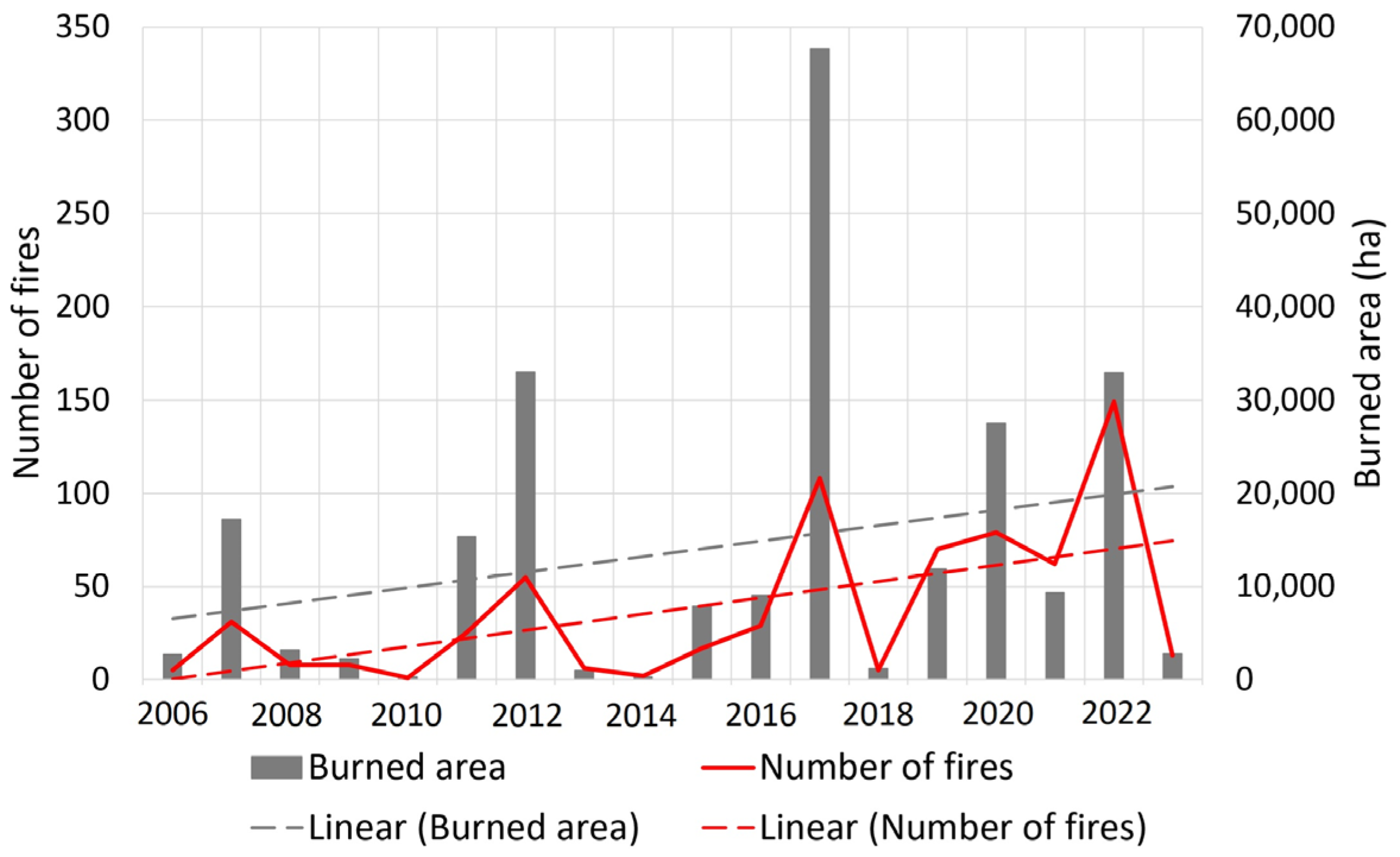

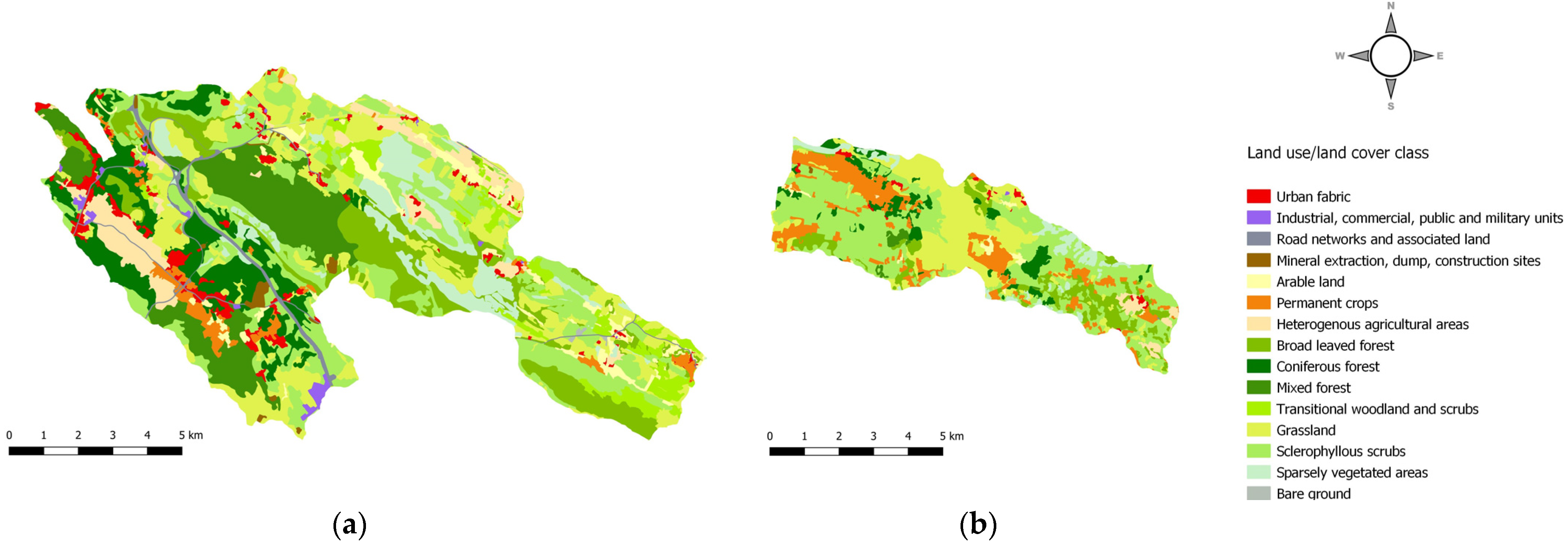
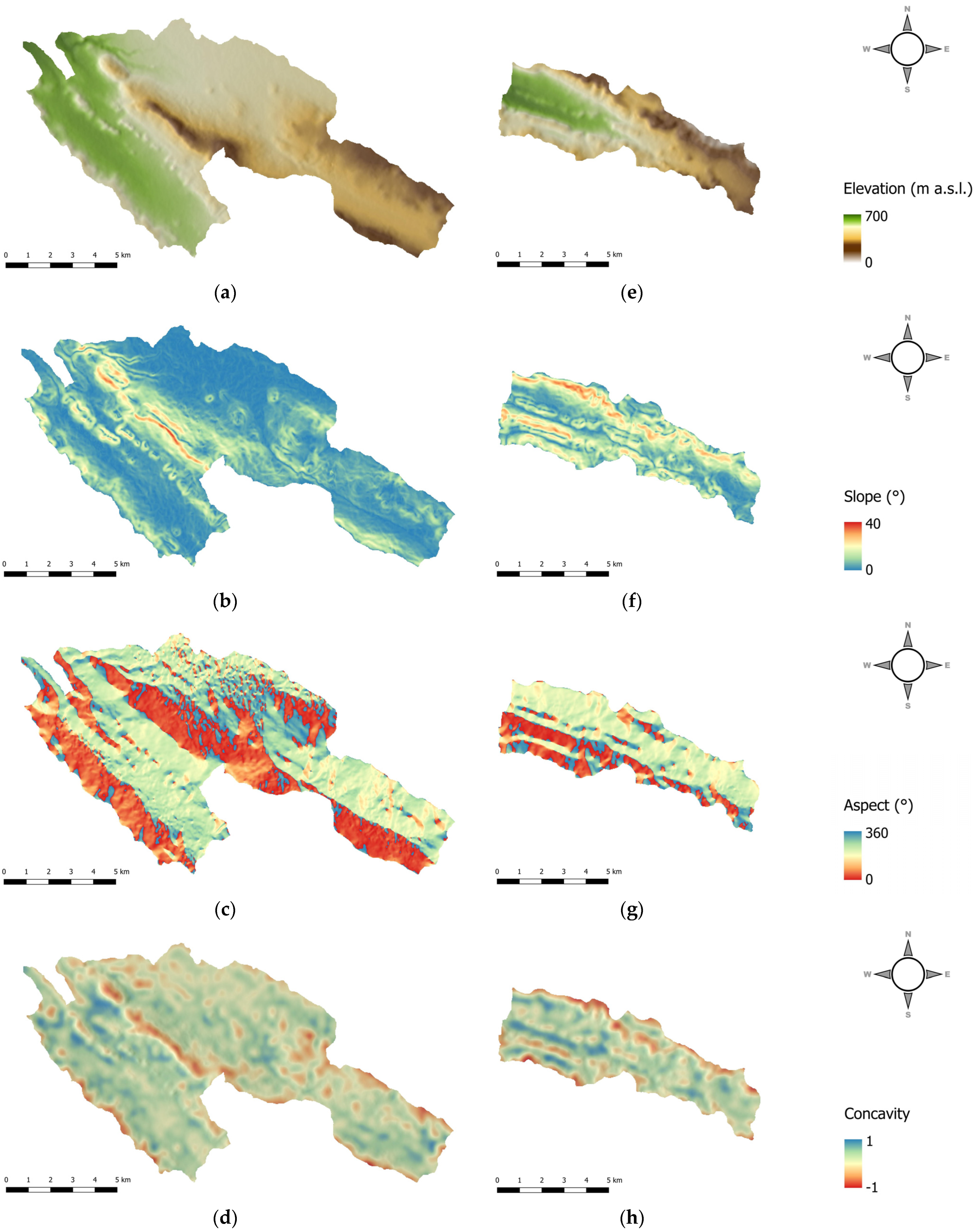


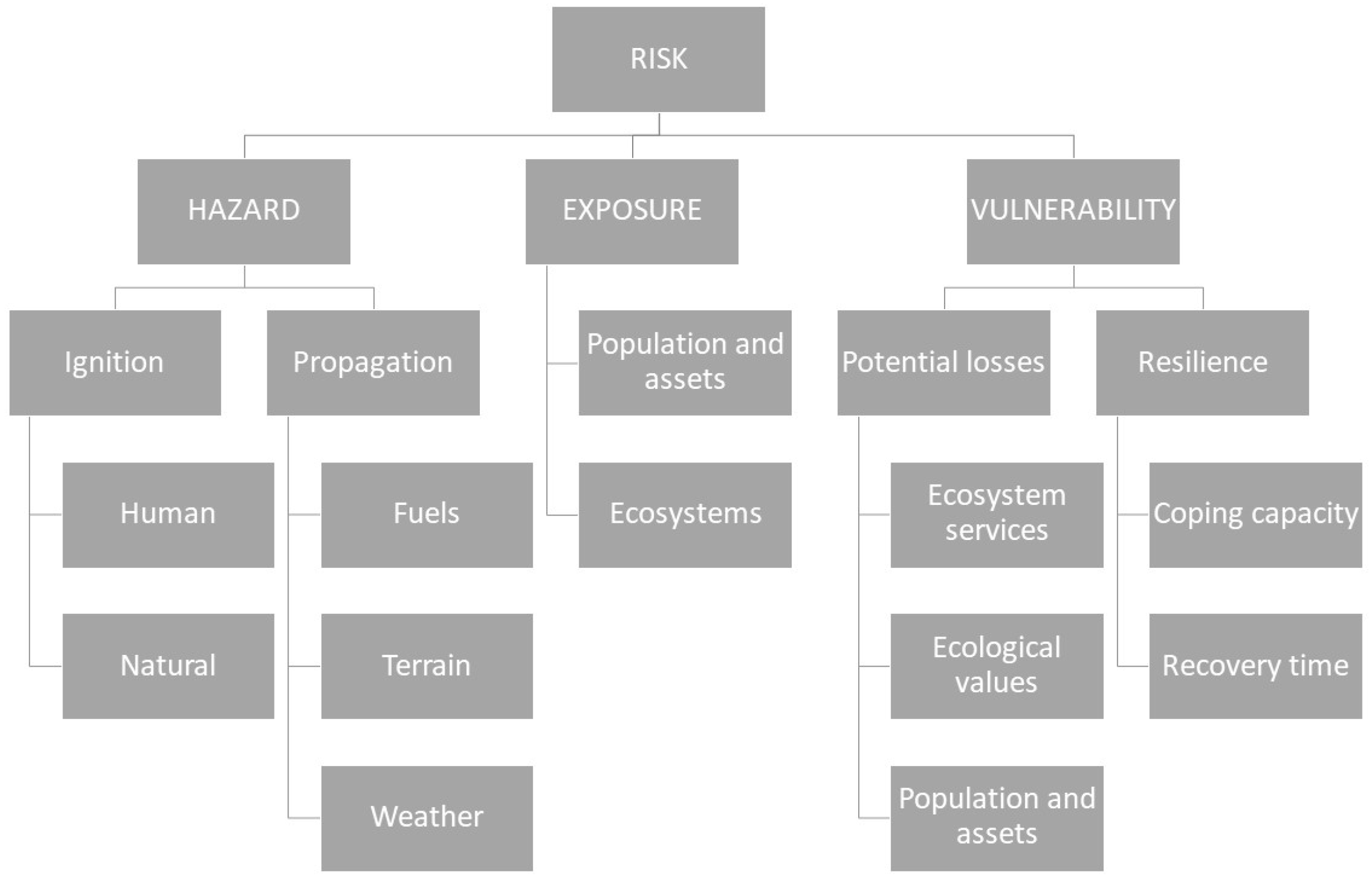

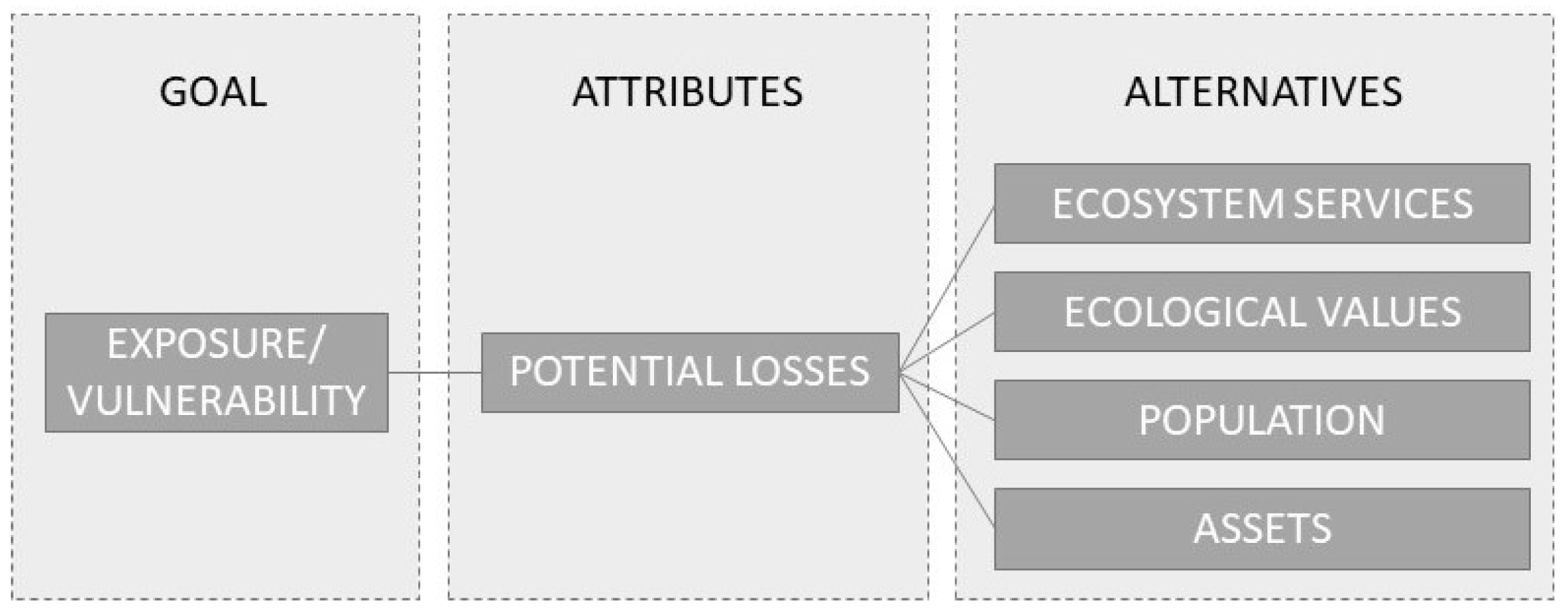
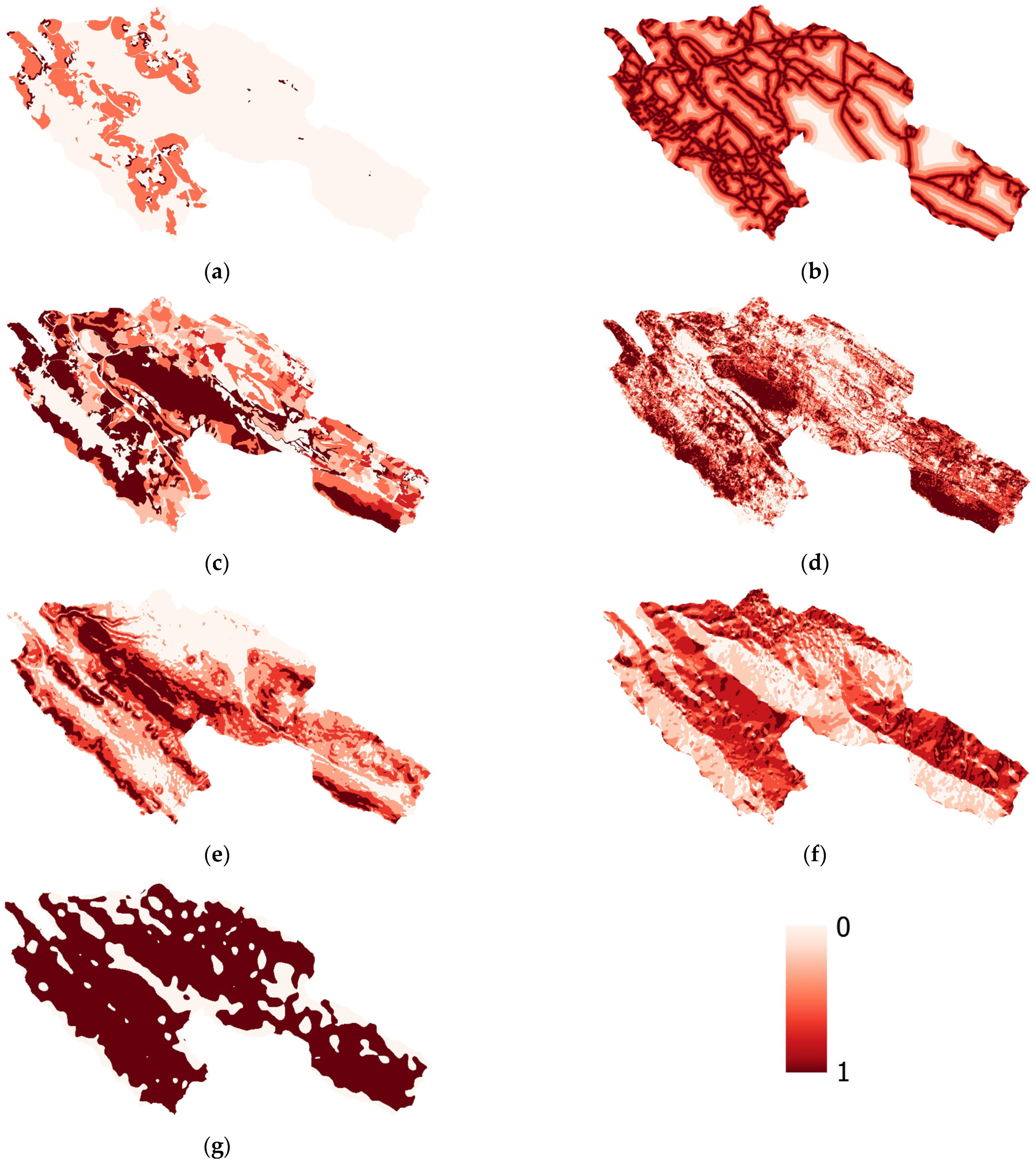



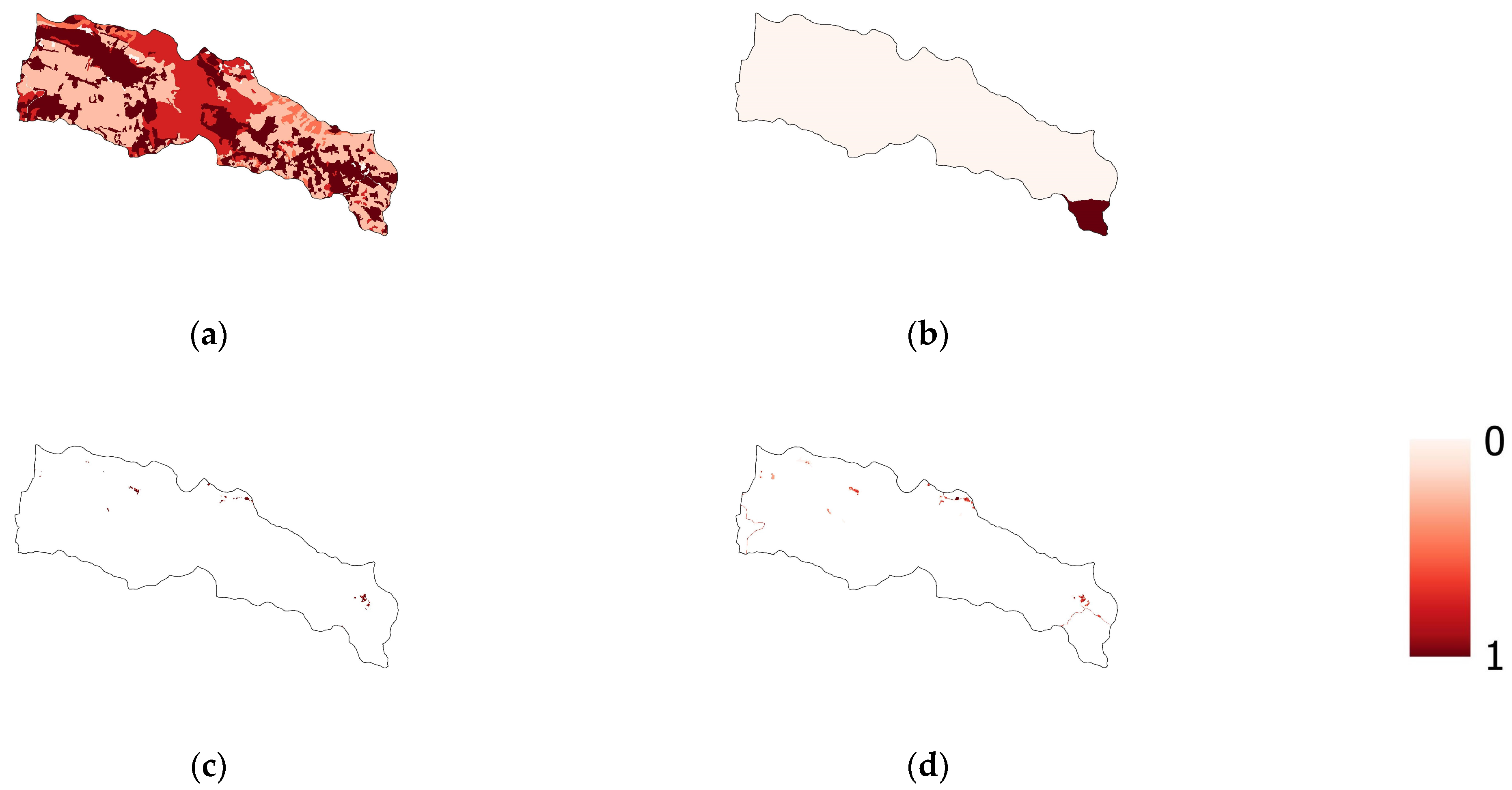

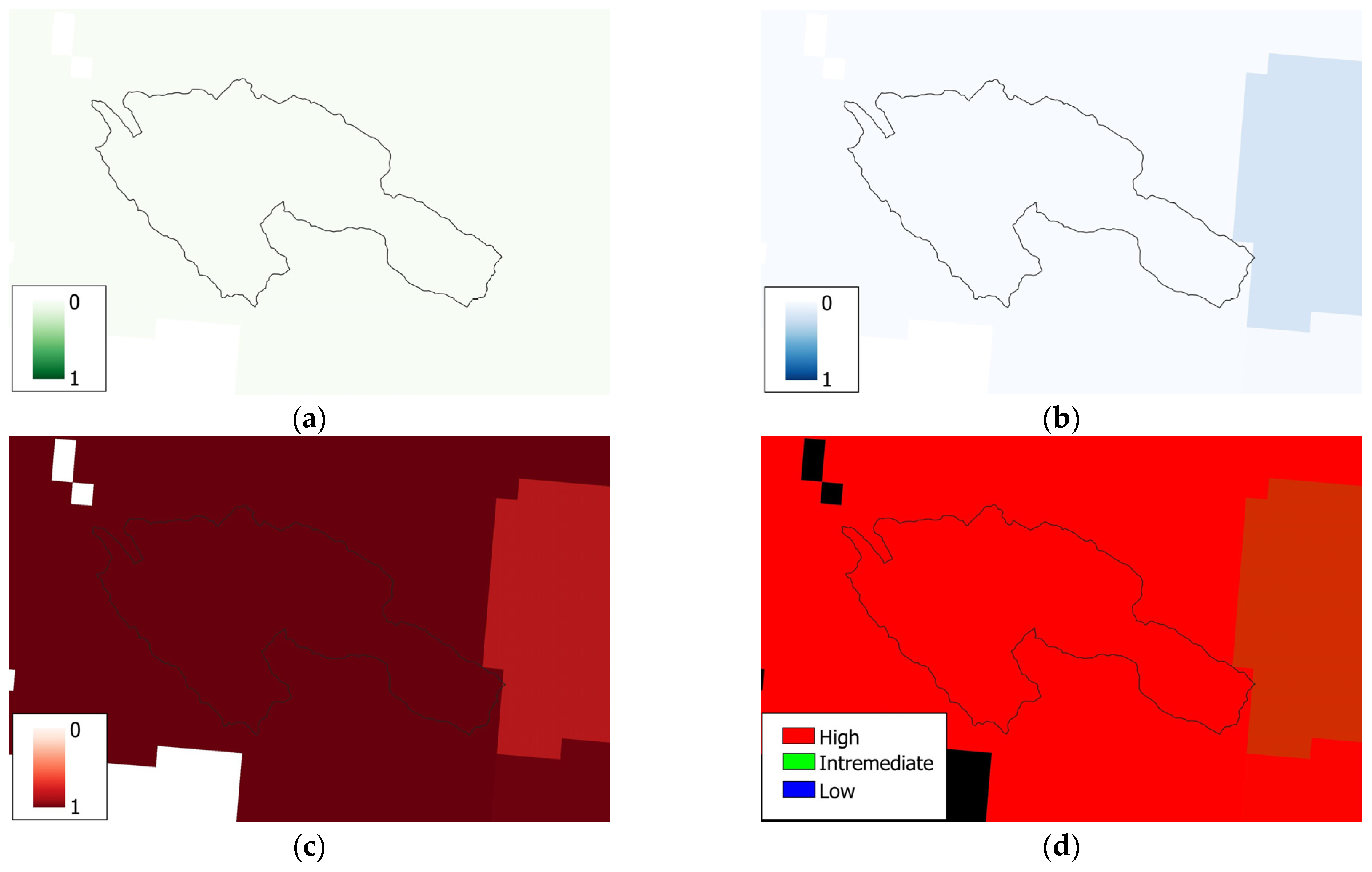
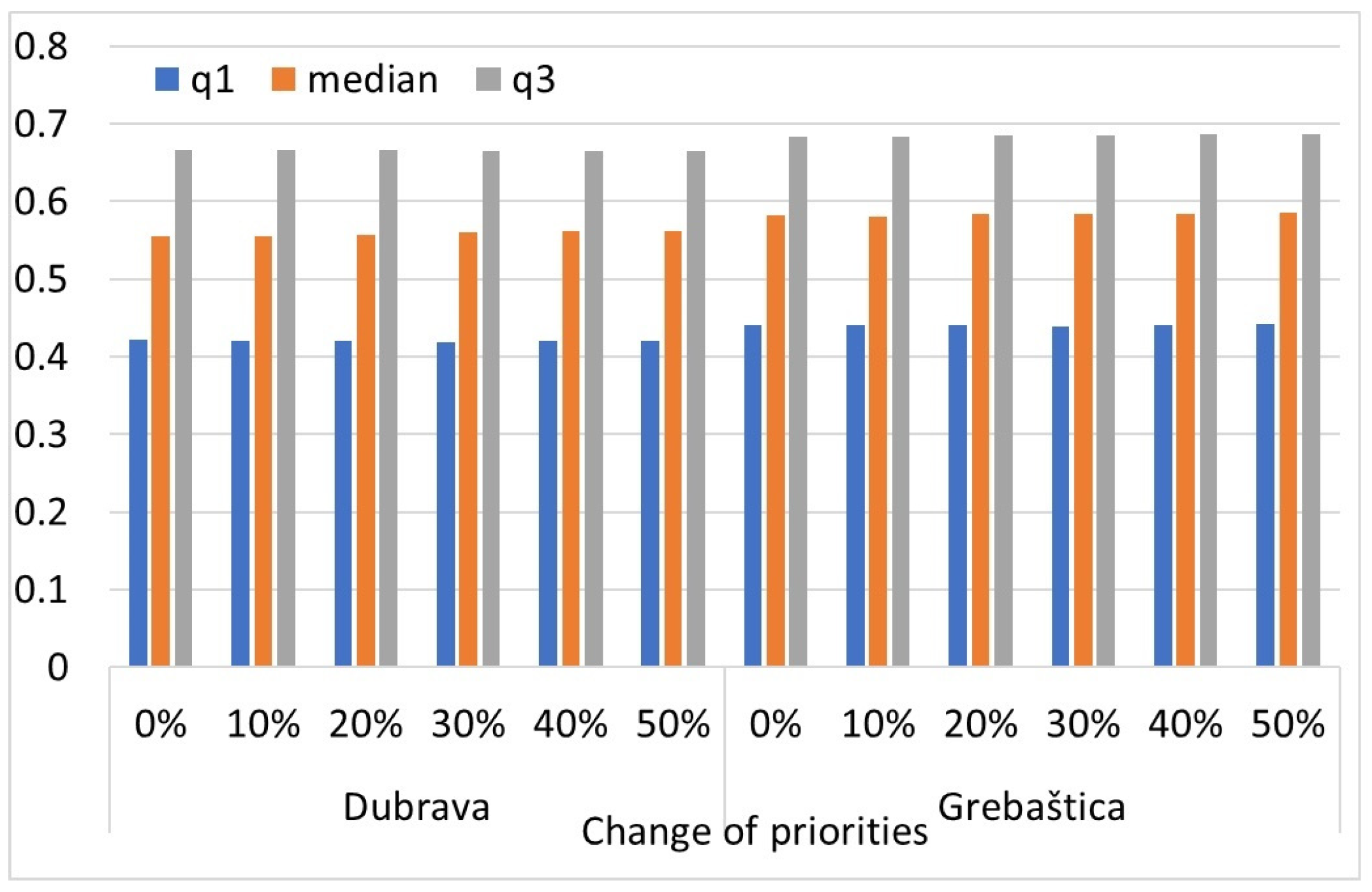
| Catchment | Platform | Date of Acquisition |
|---|---|---|
| Dubrava | Sentinel-2 | 27/06/2019 (pre-fire) |
| Sentinel-2 | 06/08/2019 (post-fire) | |
| Grebaštica | Sentinel-2 | 26/06/2023 (pre-fire) |
| Sentinel-2 | 16/07/2023 (post-fire) |
| Main LULC Class | Reclassified LULC |
|---|---|
| Urban fabric | Built-up (artificial) surfaces |
| Industrial, commercial, public, and military units | |
| Road networks and associated land | Other |
| Mineral extraction, dump, construction site | |
| Arable land | |
| Permanent crops | |
| Heterogenous agricultural areas | |
| Grassland | |
| Sparsely vegetated areas | |
| Bare ground | |
| Broad-leaved forest | Woody vegetation |
| Coniferous forest | |
| Mixed forest | |
| Transitional woodlands and shrubs | |
| Sclerophyllous shrubs |
| Fire Hazard Component | Class | Definition Component | Threshold | Susceptibility Class * |
|---|---|---|---|---|
| WUI | Intermix | Vegetation density | >50% | 1 |
| Distance | 500 m | |||
| Interface | Flammable patches of woody vegetation | >5 km2 | 2 | |
| Distance | <600 m | |||
| Distance from roads | – | – | <50 m | 5 |
| 50–100 m | 4 | |||
| 100–200 m | 3 | |||
| 200–400 m | 2 | |||
| 400–600 m | 1 | |||
| >600 m | 0 | |||
| Fuel type | Short grass | Grassland | – | 1 |
| Chaparral | Sclerophyllous shrubs | 2 | ||
| Brush | Transitional woodlands and shrubs | 3 | ||
| Hardwood litter | Broad-leaved forest | 4 | ||
| Coniferous forest | ||||
| Mixed forest | ||||
| FMC | Low | NDII | <q1 ** | 1 |
| Moderate | q1 **–median | 2 | ||
| High | median–q3 ** | 3 | ||
| Very high | >3 ** | 4 | ||
| Slope | Flat | – | <2° | 1 |
| Moderately steep | 2°–5° | 2 | ||
| Steep | 5°–10° | 3 | ||
| Very steep | >10° | 4 | ||
| Aspect | North (N) | – | 0°–22.5° | 1 |
| Northeast (NE) | 22.5°–67.5° | 2 | ||
| East (E) | 67.5°–112.5° | 3 | ||
| Southeast (SE) | 112.5°–157.5° | 4 | ||
| South (S) | 157.5°–202.5° | 6 | ||
| Southwest (SW) | 202.5°–247.5° | 5 | ||
| West (W) | 247.5°–292.5° | 4 | ||
| Northwest (NW) | 292.5°–337.5° | 3 | ||
| North (N) | 337.5°–360° | 1 | ||
| Concavity | ≤0 (convex) | – | ≤0 | 1 |
| >0 (concave) | >0 | 2 | ||
| Weather | Very low (1) | FWI | <5.2 | 1 |
| Low (2) | 5.2–11.2 | 2 | ||
| Moderate (3) | 11.2–21.3 | 3 | ||
| High (4) | 21.3–38.0 | 4 | ||
| Very high (5) | 38.0–50.0 | 5 | ||
| Extreme (6) | >50.0 | 6 |
| Catchment | NDII | Susceptibility Class |
|---|---|---|
| Dubrava | <−0.0.058 | 1 |
| −0.058–0.007 | 2 | |
| 0.007–0.087 | 3 | |
| >0.087 | 4 | |
| Grebaštica | <−0.018 | 1 |
| −0.018–0.036 | 2 | |
| 0.036–0.088 | 3 | |
| >0.088 | 4 |
| Vulnerability Component | Class | Definition Component | Threshold | Vulnerability Class |
|---|---|---|---|---|
| Population | – | Population density (inhabitants/ha) | <2 | 0 |
| 2–4 | 1 | |||
| 4–8 | 2 | |||
| 8–16 | 3 | |||
| >16 | 4 | |||
| Assets | Residential areas | IMD | 0% | 0 |
| 0–30% | 1 | |||
| 30–80% | 2 | |||
| 80–100% | 3 | |||
| Non-residential areas | Industrial, commercial, public, and military units | 3 | ||
| Road networks and associated land | – | 2 | ||
| Mineral extraction, dump, and construction sites | 1 | |||
| Ecological value | – | Natura 2000 | – | 1 |
| Main LULC Class | Ecosystem Type | Relative Supply per Ecosystem Type | Vulnerability Class |
|---|---|---|---|
| Urban fabric | Urban | 0.7% | 1 |
| Industrial, commercial, public, and military units | |||
| Road networks and associated land | |||
| Mineral extraction, dump, and construction sites | |||
| Arable land | Cropland | 35.8% | 5 |
| Permanent crops | |||
| Heterogenous agricultural areas | |||
| Grassland | Grassland | 8.6% | 4 |
| Sparsely vegetated areas | Sparsely vegetated areas | 1.7% | 3 |
| Bare ground | |||
| Broad-leaved forest | Woodland and forest | 47.5% | 5 |
| Coniferous forest | |||
| Mixed forest | |||
| Transitional woodlands and shrubs | |||
| Sclerophyllous shrubs | Heathland | 0.9% | 2 |
| dNBR | Fire Severity Class |
|---|---|
| <0.1 | Non-burned (0) |
| 0.1–0.27 | Low severity (1) |
| 0.27–0.44 | Moderately low severity (2) |
| 0.44–0.66 | Moderately high severity (3) |
| >0.66 | High severity (4) |
| Catchment | Urban Fabric | Intermix WUI | Interface WUI |
|---|---|---|---|
| Dubrava | <2% | 18.3% | 1.7% |
| Grebaštica | <1% | 9% | 3% |
| Catchment | Short Grass | Chaparral | Brush | Hardwood Litter | Other |
|---|---|---|---|---|---|
| Dubrava | 16.2% | 20.1% | 4.4% | 34.1% | 25.2% |
| Grebaštica | 21.6% | 40.5% | – | 16% | 21.9% |
| Catchment | Period | FWI Class | Reference |
|---|---|---|---|
| Dubrava | 23 July 2019–27 July 2019 | 4 (high) | [105] |
| Grebaštica | 9 July 2023–13 July 2023 | 4 (high) | [104] |
| Goal | Priorities vs. Goals | Objectives | Priorities vs. Objectives | Attributes | Priorities vs. Alternatives | Alternatives | Priorities |
|---|---|---|---|---|---|---|---|
| Hazard | 0.5 | Ignition | 0.125 | Settlements | 1 | WUI | 0.063 |
| 0.875 | Linear structures | 1 | Distance from roads | 0.438 | |||
| 0.5 | Propagation | 0.558 | Fuel | 0.25 | Fuel type | 0.070 | |
| 0.75 | FMC | 0.209 | |||||
| 0.122 | Terrain | 0.648 | Slope | 0.040 | |||
| 0.23 | Aspect | 0.014 | |||||
| 0.122 | Concavity | 0.007 | |||||
| 0.32 | Weather | 1 | FWI | 0.160 |
| Goal | Alternatives | Priority |
|---|---|---|
| Vulnerability | Ecosystem services | 0.061 |
| Ecological value | 0.102 | |
| Population | 0.729 | |
| Assets | 0.108 |
| Fire Hazard Class | dNBR Class | Area Overlap (%) | |
|---|---|---|---|
| Dubrava | Grebaštica | ||
| 1 | 1 | 23.4 | 91.0 |
| 2 | 66.6 | 8.9 | |
| 3 | 9.9 | 0.1 | |
| 4 | 0.1 | – | |
| 2 | 1 | 12.0 | 61.9 |
| 2 | 52.6 | 37.8 | |
| 3 | 33.8 | 0.3 | |
| 4 | 1.51 | – | |
| 3 | 1 | 10.8 | 49.4 |
| 2 | 35.9 | 49.4 | |
| 3 | 40.3 | 1.1 | |
| 4 | 13.0 | – | |
| 4 | 1 | 6.3 | 37.5 |
| 2 | 24.9 | 62.0 | |
| 3 | 45.5 | 0.4 | |
| 4 | 23.3 | – | |
| Hazard | ||||
|---|---|---|---|---|
| Alternative | Priority P(i) | Rank (n) | ΔMIN | dMIN |
| WUI | 0.063 | 5 | 0.007 | 11,600 |
| Distance from roads | 0.438 | 1 | 0.228 | 52.171 |
| Fuel type | 0.070 | 4 | 0.007 | 10.394 |
| FMC | 0.209 | 2 | 0.049 | 23.536 |
| Slope | 0.040 | 6 | 0.023 | 58.116 |
| Aspect | 0.014 | 7 | 0.007 | 46.957 |
| Concavity | 0.007 | 8 | 0.007 | 88.525 |
| FWI | 0.160 | 3 | 0.049 | 30.781 |
| Vulnerability | ||||
| Alternative | Priority P(i) | Rank (n) | ΔMIN | dMIN |
| Ecosystem services | 0.061 | 4 | 0.041 | 67.213 |
| Ecological value | 0.102 | 3 | 0.006 | 5.882 |
| People | 0.729 | 1 | 0.621 | 85.185 |
| Assets | 0.108 | 2 | 0.047 | 43.519 |
| Hazard | ||||||
|---|---|---|---|---|---|---|
| Alternative | P | P’ (β = 10%) α = 0.007 | P’ (β = 20%) α = 0.014 | P’ (β = 30%) α = 0.021 | P’ (β = 40%) α = 0.028 | P’ (β = 50%) α = 0.035 |
| WUI | 0.063 | 0.063 | 0.063 | 0.064 | 0.064 | 0.065 |
| Distance from roads | 0.438 | 0.441 | 0.444 | 0.447 | 0.450 | 0.453 |
| Fuel type | 0.070 * | 0.063 | 0.057 | 0.050 | 0.043 | 0.036 |
| FMC | 0.209 | 0.211 | 0.212 | 0.214 | 0.215 | 0.217 |
| Slope | 0.040 | 0.040 | 0.040 | 0.040 | 0.041 | 0.041 |
| Aspect | 0.014 | 0.014 | 0.014 | 0.014 | 0.014 | 0.015 |
| Concavity | 0.007 | 0.007 | 0.008 | 0.008 | 0.008 | 0.008 |
| FWI | 0.160 | 0.161 | 0.162 | 0.163 | 0.165 | 0.166 |
| Vulnerability | ||||||
| Alternative | P | P’ (β = 10%) α = 0.010 | P’ (β = 20%) α = 0.020 | P’ (β = 30%) α = 0.031 | P’ (β = 40%) α = 0.041 | P’ (β = 50%) α = 0.051 |
| Ecosystem services | 0.061 | 0.062 | 0.062 | 0.063 | 0.064 | 0.064 |
| Ecological value | 0.102 * | 0.093 | 0.083 | 0.074 | 0.064 | 0.054 |
| People | 0.729 | 0.737 | 0.744 | 0.752 | 0.760 | 0.768 |
| Assets | 0.108 | 0.109 | 0.110 | 0.111 | 0.113 | 0.114 |
| Fire Hazard Class | dNBR Class | Area Overlap (%) for β = 20% | Deviation from the Initial Values (%) for β = 0% | ||
|---|---|---|---|---|---|
| Dubrava | Grebaštica | Dubrava | Grebaštica | ||
| 1 | 1 | 25.1 | 89.6 | 7.1 | −1.5 |
| 2 | 65.3 | 8.0 | −2.0 | −9.8 | |
| 3 | 9.6 | 0.07 | −3.0 | 20.7 | |
| 4 | 0.06 | – | 5.3 | – | |
| 2 | 1 | 12.8 | 63.2 | 6.3 | 2.2 |
| 2 | 52.2 | 34.3 | −0.8 | −9.2 | |
| 3 | 33.7 | 0.3 | −0.4 | 9.9 | |
| 4 | 1.4 | – | −7.3 | – | |
| 3 | 1 | 11.9 | 52.3 | 9.9 | 5.9 |
| 2 | 34.2 | 44.7 | −4.7 | −9.5 | |
| 3 | 39.3 | 1.0 | −2.4 | −12.7 | |
| 4 | 14.7 | – | 13.1 | – | |
| 4 | 1 | 7.6 | 42.0 | 20.6 | 12.0 |
| 2 | 25.9 | 55.8 | 4.1 | −10.1 | |
| 3 | 44.8 | 0.3 | −1.5 | −20.0 | |
| 4 | 21.6 | – | −7.4 | – | |
Disclaimer/Publisher’s Note: The statements, opinions and data contained in all publications are solely those of the individual author(s) and contributor(s) and not of MDPI and/or the editor(s). MDPI and/or the editor(s) disclaim responsibility for any injury to people or property resulting from any ideas, methods, instructions or products referred to in the content. |
© 2024 by the authors. Licensee MDPI, Basel, Switzerland. This article is an open access article distributed under the terms and conditions of the Creative Commons Attribution (CC BY) license (https://creativecommons.org/licenses/by/4.0/).
Share and Cite
Horvat, B.; Karleuša, B. Conceptual Model for Integrated Meso-Scale Fire Risk Assessment in the Coastal Catchments in Croatia. Remote Sens. 2024, 16, 2118. https://doi.org/10.3390/rs16122118
Horvat B, Karleuša B. Conceptual Model for Integrated Meso-Scale Fire Risk Assessment in the Coastal Catchments in Croatia. Remote Sensing. 2024; 16(12):2118. https://doi.org/10.3390/rs16122118
Chicago/Turabian StyleHorvat, Bojana, and Barbara Karleuša. 2024. "Conceptual Model for Integrated Meso-Scale Fire Risk Assessment in the Coastal Catchments in Croatia" Remote Sensing 16, no. 12: 2118. https://doi.org/10.3390/rs16122118
APA StyleHorvat, B., & Karleuša, B. (2024). Conceptual Model for Integrated Meso-Scale Fire Risk Assessment in the Coastal Catchments in Croatia. Remote Sensing, 16(12), 2118. https://doi.org/10.3390/rs16122118







